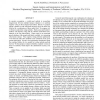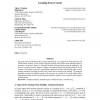113
click to vote
ICASSP
2011
IEEE
14 years 4 months ago
2011
IEEE
In emotion recognition, a widely-used method to reconciliate disagreement between multiple human evaluators is to perform majority-voting on their assigned class labels. Instead, ...
113
click to vote
JMLR
2010
14 years 7 months ago
2010
We consider a supervised learning setting in which the main cost of learning is the number of training labels and one can obtain a single label for a bag of examples, indicating o...
113
click to vote
JMLR
2010
14 years 7 months ago
2010
For many supervised learning tasks it may be infeasible (or very expensive) to obtain objective and reliable labels. Instead, we can collect subjective (possibly noisy) labels fro...
137
click to vote
CVPR
2011
IEEE
14 years 8 months ago
2011
IEEE
We propose structured models for image labeling that take into account the dependencies among the image labels explicitly. These models are more expressive than independent label ...
161
click to vote
CVPR
2011
IEEE
14 years 9 months ago
2011
IEEE
A label consistent K-SVD (LC-KSVD) algorithm to learn a discriminative dictionary for sparse coding is presented. In addition to using class labels of training data, we also assoc...
IJON
2010
14 years 10 months ago
2010
The pairwise approach to multilabel classification reduces the problem to learning and aggregating preference predictions among the possible labels. A key problem is the need to qu...
159
click to vote
DATAMINE
2010
14 years 10 months ago
2010
: In dyadic prediction, the input consists of a pair of items (a dyad), and the goal is to predict the value of an observation related to the dyad. Special cases of dyadic predicti...
133
click to vote
CONSTRAINTS
2010
14 years 10 months ago
2010
The subgraph isomorphism problem consists in deciding if there exists a copy of a pattern graph in a target graph. We introduce in this paper a global constraint and an associated ...
123
click to vote
UIST
2010
ACM
14 years 10 months ago
2010
ACM
An important aspect of making the Web accessible to blind users is ensuring that all important web page elements such as links, clickable buttons, and form fields have explicitly ...
INLG
2010
Springer
14 years 10 months ago
2010
Springer
We present the UMUS (Universit




